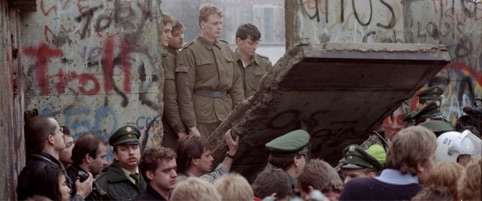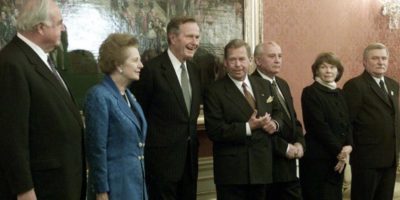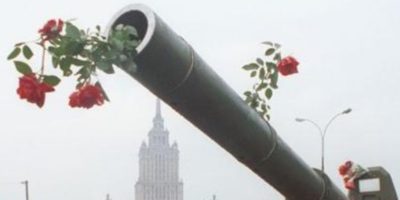The thirteenth in a series about the spiritual revolution behind the fall of communism thirty years ago.
Few readers under forty years of age will remember the sense of shock and amazement that spread across western and central Europe exactly thirty years ago this week, as television screens carried direct reports of the Berlin Wall being hacked open by euphoric crowds on both sides.
Erected in 1961, the Berlin Wall was the iconic symbol of the Iron Curtain era and the separation of east and west, communism and capitalism. The wall ‘protected’ the Eastern bloc from ‘fascist’ elements in the west wishing to subvert the ‘will of the people’ from building the socialist state of the DDR (German Democratic Republic). Communist authorities called it the Antifaschistischer Schutzwall (Anti-Fascist Protection Rampart). Willy Brandt, then the mayor of Western Berlin, dubbed it the Wand der Schande, the Wall of Shame.
Only one in twenty of the estimated 100,000 who attempted to escape over the wall succeeded. Up to 200 lost their lives in the effort.
In 1987, on the 750th anniversary of the city of Berlin, Ronald Reagan had spoken directly to his Soviet counterpart before a large crowd gathered at the Brandenburg Gate: ‘General Secretary Gorbachev, if you seek peace, if you seek prosperity for the Soviet Union and eastern Europe, come here to this gate. Mr. Gorbachev, open this gate. Mr. Gorbachev, tear down this Wall!’
‘100 more years’
As late as January 1989, the DDR’s leader Erich Honecker had declared defiantly that ‘the Wall would stand for 50 or 100 more years if the conditions that had caused its construction did not change.’
In August, however, Austrian and Hungarian authorities had begun removing the barbed wire curtain, inspiring the Pan-European Picnic and triggering the escape of hundreds over the border. The prayer-and-peace movement in Leipzig had been building up over seven years, and by the autumn of 1989 the Nikolaikirche was overflowing with thousands standing outside.
On October 7, even as Honecker and Gorbachev celebrated together the 40th anniversary of the DDR in Berlin, civil unrest spread from the streets of Leipzig to Dresden and other cities. Stasi and police arrested many protestors. Despite his promises of the wall’s longevity, Honecker himself lasted a mere ten days before being unceremoniously dumped. His replacement Egon Krenz promised political reform in his inaugural address, using the term Die Wende (meaning ‘turnaround’).
This helped to open the floodgates further. First two hundred thousand, then three hundred thousand demonstrated in Leipzig, while tens of thousands protested in the streets in Magdeburg, Dresden, Zwickau, Halle and Berlin, among other cities.
‘No violence’
In reaction to violent police assaults on peaceful protesters during the 40th anniversary commemorations, up to one million people gathered in the Alexanderplatz in East Berlin on November 4, demanding the authorities to uphold constitutional guarantees of freedom of speech and freedom of assembly. Organised by actors and theatre employers, it was one of the largest demonstrations in East Germany’s history. Demonstrators joined in from all over East Germany, carrying banners including: ‘40 Jahre sind genu’ (40 years are enough) and ‘Bürgerrechte nicht nur auf Papier’ (Civil rights not only on paper).
The Stasi, not knowing whether to ban the gathering or subvert it, had spread rumours that the protesters were planning to march toward the Brandenburg Gate at the Berlin Wall. This would have given an excuse for the authorities to move in with force. The organizers issued yellow sashes for the marshals to wear with the words ‘Kein Gewalt!’ (‘No violence!’). Live television beamed to the whole nation the jeers and boos greeting representatives of the regime who addressed the crowd during the three-hour-long demonstration.
On November 8, the whole politburo resigned and a committee was set up to draft new laws on travel. The next day, November 9, the draft was passed on to a regime spokesman, Günter Schabowski, in the middle of a press conference, who duly read the text. He heard himself reading that travel to the West would forthrightly be allowed. (In retrospect it was apparently intended that visas would still need to be issued.) When a journalist asked incredulously if that meant that any East German could cross the border, Schabowski simply agreed that that seemed to be what the text implied.
Pandemonium broke out. News spread like wildfire. People, some in pyjamas, converged in their Trabant cars on transit points in Berlin, bewildering the border guards who shrugged their shoulders, stepped back and let the euphoric crowds through.
Others climbed up on the wall and began attacking it with pick axes. People from a divided nation began to hug each other, weeping and dancing together. The Wall had fallen!
German reunification formally took place on 3 October 1990.
Till next week,



